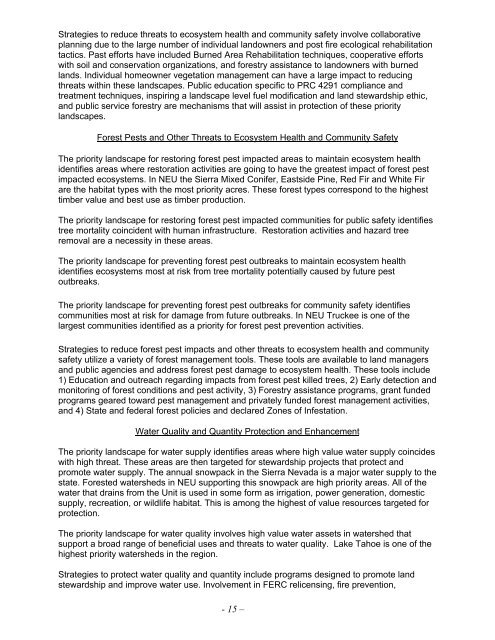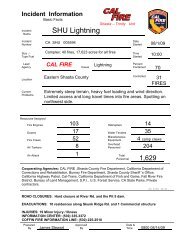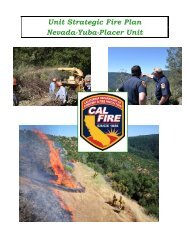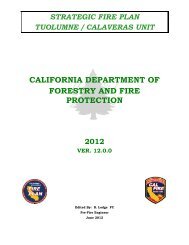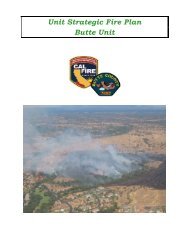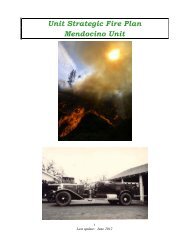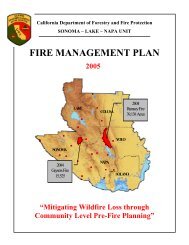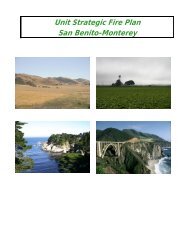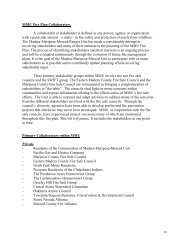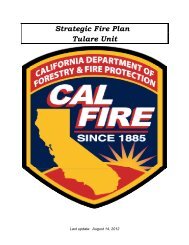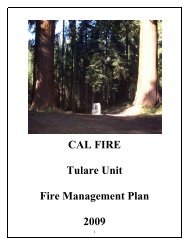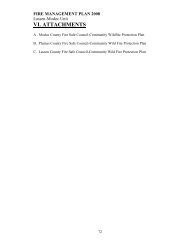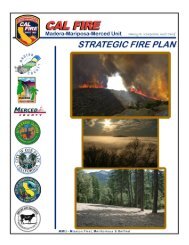Nevada-Yuba-Placer Strategic Fire Plan 2011 - Board of Forestry ...
Nevada-Yuba-Placer Strategic Fire Plan 2011 - Board of Forestry ...
Nevada-Yuba-Placer Strategic Fire Plan 2011 - Board of Forestry ...
You also want an ePaper? Increase the reach of your titles
YUMPU automatically turns print PDFs into web optimized ePapers that Google loves.
Strategies to reduce threats to ecosystem health and community safety involve collaborative<br />
planning due to the large number <strong>of</strong> individual landowners and post fire ecological rehabilitation<br />
tactics. Past efforts have included Burned Area Rehabilitation techniques, cooperative efforts<br />
with soil and conservation organizations, and forestry assistance to landowners with burned<br />
lands. Individual homeowner vegetation management can have a large impact to reducing<br />
threats within these landscapes. Public education specific to PRC 4291 compliance and<br />
treatment techniques, inspiring a landscape level fuel modification and land stewardship ethic,<br />
and public service forestry are mechanisms that will assist in protection <strong>of</strong> these priority<br />
landscapes.<br />
Forest Pests and Other Threats to Ecosystem Health and Community Safety<br />
The priority landscape for restoring forest pest impacted areas to maintain ecosystem health<br />
identifies areas where restoration activities are going to have the greatest impact <strong>of</strong> forest pest<br />
impacted ecosystems. In NEU the Sierra Mixed Conifer, Eastside Pine, Red Fir and White Fir<br />
are the habitat types with the most priority acres. These forest types correspond to the highest<br />
timber value and best use as timber production.<br />
The priority landscape for restoring forest pest impacted communities for public safety identifies<br />
tree mortality coincident with human infrastructure. Restoration activities and hazard tree<br />
removal are a necessity in these areas.<br />
The priority landscape for preventing forest pest outbreaks to maintain ecosystem health<br />
identifies ecosystems most at risk from tree mortality potentially caused by future pest<br />
outbreaks.<br />
The priority landscape for preventing forest pest outbreaks for community safety identifies<br />
communities most at risk for damage from future outbreaks. In NEU Truckee is one <strong>of</strong> the<br />
largest communities identified as a priority for forest pest prevention activities.<br />
Strategies to reduce forest pest impacts and other threats to ecosystem health and community<br />
safety utilize a variety <strong>of</strong> forest management tools. These tools are available to land managers<br />
and public agencies and address forest pest damage to ecosystem health. These tools include<br />
1) Education and outreach regarding impacts from forest pest killed trees, 2) Early detection and<br />
monitoring <strong>of</strong> forest conditions and pest activity, 3) <strong>Forestry</strong> assistance programs, grant funded<br />
programs geared toward pest management and privately funded forest management activities,<br />
and 4) State and federal forest policies and declared Zones <strong>of</strong> Infestation.<br />
Water Quality and Quantity Protection and Enhancement<br />
The priority landscape for water supply identifies areas where high value water supply coincides<br />
with high threat. These areas are then targeted for stewardship projects that protect and<br />
promote water supply. The annual snowpack in the Sierra <strong>Nevada</strong> is a major water supply to the<br />
state. Forested watersheds in NEU supporting this snowpack are high priority areas. All <strong>of</strong> the<br />
water that drains from the Unit is used in some form as irrigation, power generation, domestic<br />
supply, recreation, or wildlife habitat. This is among the highest <strong>of</strong> value resources targeted for<br />
protection.<br />
The priority landscape for water quality involves high value water assets in watershed that<br />
support a broad range <strong>of</strong> beneficial uses and threats to water quality. Lake Tahoe is one <strong>of</strong> the<br />
highest priority watersheds in the region.<br />
Strategies to protect water quality and quantity include programs designed to promote land<br />
stewardship and improve water use. Involvement in FERC relicensing, fire prevention,<br />
- 15 –


